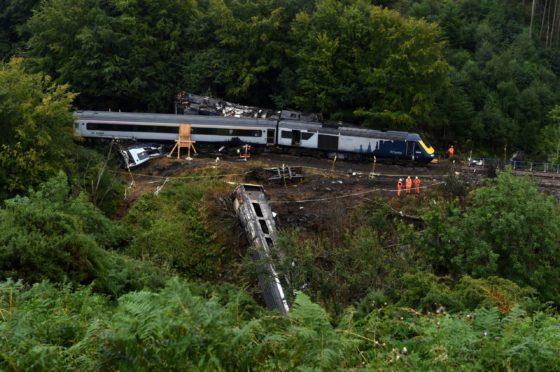A rail engineer has called for the type of train involved in the tragic Stonehaven derailment to be scrapped amid safety concerns.
Gareth Dennis has said the high speed trains, known as HSTs, are based on an outdated 50-year-old design that should no longer be used as they offer a lack of protection compared to modern designs.
Mr Dennis, speaking to The Scotsman, said other companies such as LNER have already scrapped use of the HSTs, however, ScotRail, currently being operated by Abellio, has not and has instead acquired and refurbished the trains for use on inter-city services.
One of the trains tragically derailed in August near Stonehaven after colliding with stones that had washed onto the tracks amid heavy rain.
Driver Brett McCullough, 45, conductor Donald Dinnie, 58, and passenger Christopher Stuchbury, 62, died in the crash, with six others aboard the train injured.
-
The 06.54 from Stonehaven
-
‘Our lives will never be the same again’: Family of Stonehaven train driver Brett speak for first time about devastating loss
-
‘Dad truly was one of a kind’: Family of smiling conductor Donald Dinnie killed in Stonehaven rail crash say he will never be forgotten
-
Stonehaven rail crash victim Christopher Stuchbury was ‘a man much loved by all who knew him’
-
Community came together as one following Stonehaven rail tragedy
‘Appalling’ trains are used for front line services
Mr Dennis said: “The HST has no modern crashworthiness features – none at all.
“I think it’s pretty appalling that we’re still using those trains in front line service.”
Mr Dennis raised particular concern for drivers of the trains and the lack of protection offered, which he described as “unacceptable”.
“I’m amazed they have not been blacklisted as a result of Carmont.”
Speaking on his Rail Natter podcast, Mr Dennis said: “I adore it but it’s a museum piece.
“It shouldn’t be running in regular service any more.
“Drivers should not be operating these trains. It is as simple as that.
“The HST cab is essentially an upturned bath tub mounted facing outwards with a driver inside it.
“There is zero crash structure for the cab – absolutely zero crashworthiness whatsoever.
“Zero protection for the driver.
“All there is the base of the front of the HST with a fibreglass shell over the front.
“There is no crash structure at all.
“I’m amazed they have not been blacklisted as a result of Carmont.”
Referring to crashworthiness being investigated by the RAIB, Mr Dennis said: “I hope the RAIB do not pull their punches.”
Hope for change earlier than anticipated 2030 target
He also compared the incident to the crash of a more modern Virgin Trains’ Pendolino at Grayrigg, near Kendal in Cumbria in 2007, in which only one person had died despite the train being heavier and travelling faster.
Mr Dennis told The Scotsman he hoped Transport Scotland would now plan for an earlier replacement of the HSTs than the current 2030 target date.
He said: “By raising the lack of crashworthiness in these vehicles, there’s a chance that might accelerate some of those discussions.
“My hope is it will be in the next few years.”
He added: “Railways remain the safest form of overland transit by a very long way, but that doesn’t mean the rail industry shouldn’t be striving for better safety.”
The Scotsman said ScotRail said it was unable to comment pending the RAIB investigation.
The drivers’ union Aslef and Transport Scotland declined to comment.










